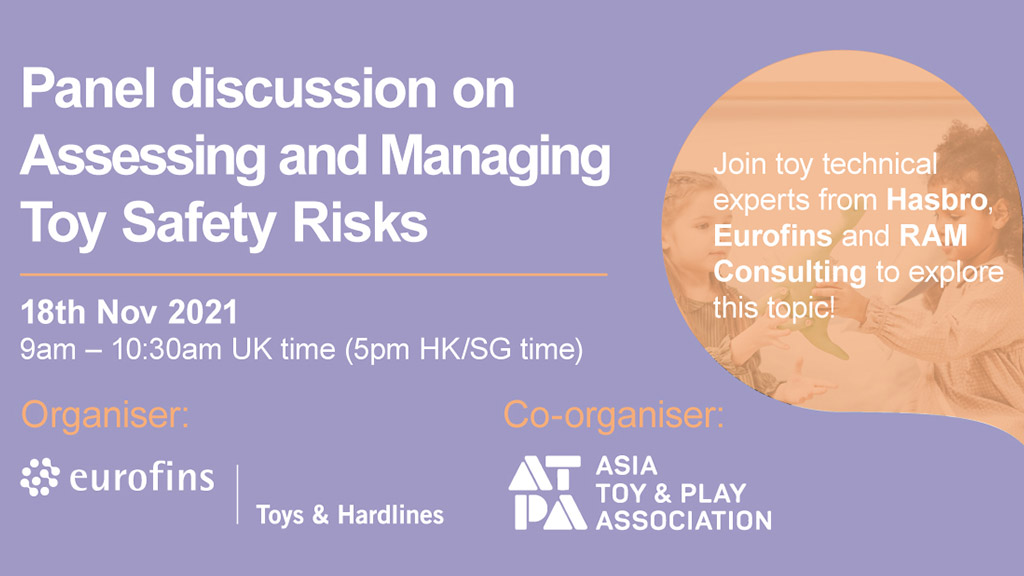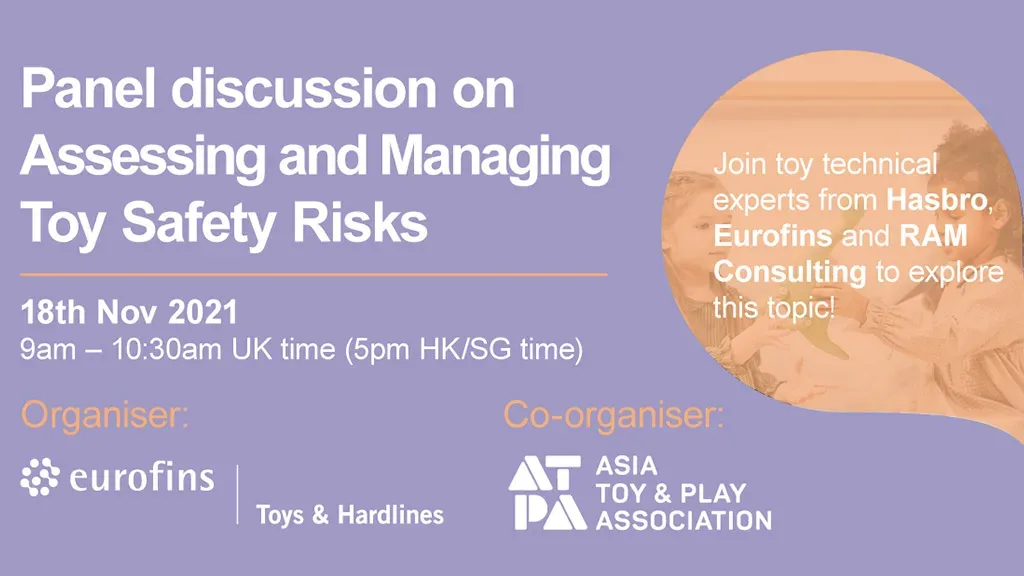
Play is serious business, especially when it comes to worldwide toy safety compliance.
Eurofins and the Asia Toy & Play Association (ATPA) hosted a panel discussion on Nov. 18 about assessing and managing toy safety risks. Attendees had the chance to hear from experts from Hasbro, ATPA, RAM Consulting, and Eurofins, who discussed the basics on toy safety, including interpreting safety and risks from product regulations, developing products beyond regulatory requirements, and encompassing global regulations and integrating requirements into compliance process.
Speakers included Nicolas Dimier, manager, quality assurance, Hasbro; Claire Francis, regulatory manager, Eurofins Product Testing UK; Henrique De Abreu Peixe, technical expert – toys, Eurofins ATS; and Dr. Nelson Chan, president, RAM Consulting. The Toy Book caught up with each speaker to talk about toy safety in each of their areas of expertise.
Click here to view the panel discussion now on-demand titled “Assessing and Managing Toy Safety Risks” from Eurofins and the Asia Toy & Play Association (ATPA), and scroll down below to read the Q&A.
 Describe the typical testing process and timeline that toys go through in order to meet safety standards.
Describe the typical testing process and timeline that toys go through in order to meet safety standards.
Claire Francis: It is beneficial to conduct a safety assessment at conceptual stages as this allows for modifications to be made early on, before any significant time, emotional, or monetary investment is made. It would be costly and time-consuming if changes were needed in later stages of production, so it is key to conduct the safety assessment as early as possible to iron out any non-conformances and reduce hazards prior to production.
The safety assessment will also help define the testing program relevant to the toy e.g., EN 71-1/2/3, appendix C, applicable entries of REACH, POP’s, etc., and help the manufacturer establish which conformity assessment procedure they are required to follow i.e., self-verification or third-party verification.
Raw materials may be tested early on to check that they are suitable for use and function as intended. Pre-production samples will be tested to the applicable mandatory legal safety standards to check that they are compliant.
If raw materials and pre-production samples are deemed satisfactory, the manufacturer will move onto production; production samples will be tested to the applicable mandatory legal safety standards. Routine testing for specific tests/test methods may be repeated on production samples to check the manufacturer’s quality assurance process is robust and that the toy is consistently manufactured as per their safety design.
The testing timeline is only likely to be short, maybe a couple of weeks, but planning the various requirements to be conducted at the right times within the supply chain development is important.
 What are some of the top toy safety factors that R&D teams need to keep in mind as they are developing toys?
What are some of the top toy safety factors that R&D teams need to keep in mind as they are developing toys?
Nicolas Dimier: Manufacturers need to navigate a complex and constantly evolving global regulatory landscape.
It’s important for them to stay ahead of the curve and integrate the requirements in the design process. They need to look at the bigger regulatory picture and avoid the trap of only considering applicable voluntary standards and certification testing.
Compliance is very often a design matter and testing should only be a verification process.
 What are some of the most common behavioral factors that can become risk factors when kids play with toys?
What are some of the most common behavioral factors that can become risk factors when kids play with toys?
Dr. Nelson Chan: Children go through various developmental stages from infant, toddler, preschool, to teenagers. In each of these developmental stages, children behave slightly differently and use different types of exploration strategies to explore their environment.
At the infant and toddler stage, children do a lot of mouthing to understand the world and this is the reason we see a lot of choking incidents. At the pre-school stage, children develop more physical abilities but lack the cause and consequences understanding. At this stage, there are many impact, projectile, and entrapment injuries.
As children grow older, they become more risk-taking and like to test the limit of both themselves and the product. This is the stage where there are many fall and impact injuries.
Severe injuries can become fatalities if the product, especially a toy, is not designed well with children’s behavior in mind and is not manufactured with the required quality.
 What are some of the most common safety hazards for toys?
What are some of the most common safety hazards for toys?
Henrique De Abreu Peixe: In mechanical terms, the most common hazard that can be found in toys is related to small parts. Small parts are mostly a concern for children below 3 years old that have the tendency to put whatever comes to their hands into their mouths. Manufacturers are widely aware of that but we still find items that are for very young children and can have small parts detached.
If we were to narrow the view, the most difficult toys to manufacture are probably those made of wood. Indeed, wood is a natural material and its properties might be different from one piece to the other, making it a challenge to manufacture a toy and ensure the whole production is safe.
Another toy safety hazard would be the accessibility of filling materials in plush toys. Seams are sometimes weak and the expertise of needleworkers is essential to guarantee that children won’t gain access to the filling material through a cracked seam.
Lastly, cords are always a big concern. Cords have the potential to accidentally go around necks and may cause strangulation. This is an aspect that is well defined in standards and scenarios of entangling are anticipated in order to make sure that none of the cords can become an unexpected source of hazard.
As for electrical toys, the battery compartment is usually an area that is attractive to children. The fact that it contains batteries is a risk for younger children, in particular when button batteries are used, as they may be swallowed and their chemical composition is very harmful to health.
In addition to that, overheating of toy products can lead to burns and most of the time heat is not visible so children might inadvertently touch surfaces that have become very hot.
Click here to view the panel discussion now on-demand titled “Assessing and Managing Toy Safety Risks” from Eurofins and the Asia Toy & Play Association (ATPA), and scroll down below to read the Q&A.

